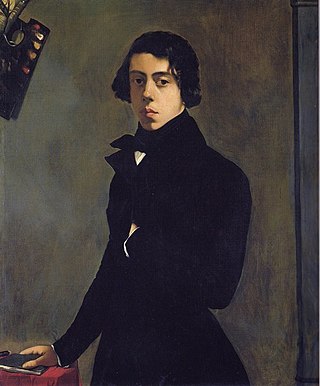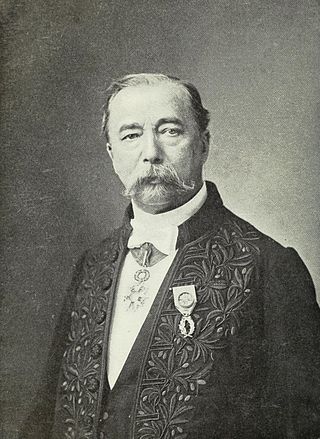Early life
Charles Porion was born on 1 May 1814 in Amiens. [2] He was trained by Michel Martin Drolling and Jean-Auguste-Dominique Ingres. [2]

Charles Porion | |
|---|---|
| Born | 1 May 1814 Amiens, Somme, France |
| Died | 1908 |
| Occupation | Painter |
Charles Porion (1814–1908 [1] [lower-alpha 1] ) was a French painter.
Charles Porion was born on 1 May 1814 in Amiens. [2] He was trained by Michel Martin Drolling and Jean-Auguste-Dominique Ingres. [2]

Porion came second at the 1840 Prix de Rome. [3] He exhibited at the Salon from 1844 to 1868, where he won a bronze medal in 1844. [2] He became a knight of the Légion d'Honneur in 1884. [2]

Jean Frédéric Bazille was a French Impressionist painter. Many of Bazille's major works are examples of figure painting in which he placed the subject figure within a landscape painted en plein air.

Alexandre Cabanel was a French painter. He painted historical, classical and religious subjects in the academic style. He was also well known as a portrait painter. According to Diccionario Enciclopedico Salvat, Cabanel is the best representative of L'art pompier, and was Napoleon III's preferred painter.

Jean Alexandre Joseph Falguière was a French sculptor and painter.
Events from the year 1864 in art.

Théodore Chassériau was a Dominican-born French Romantic painter noted for his portraits, historical and religious paintings, allegorical murals, and Orientalist images inspired by his travels to Algeria. Early in his career he painted in a Neoclassical style close to that of his teacher Jean-Auguste-Dominique Ingres, but in his later works he was strongly influenced by the Romantic style of Eugène Delacroix. He was a prolific draftsman, and made a suite of prints to illustrate Shakespeare's Othello. The portrait he painted at the age of 15 of Prosper Marilhat, makes Théodore Chassériau the youngest painter exhibited at the Louvre museum.

Jules Joseph Lefebvre was a French figure painter, educator and theorist.

Jean-Jacques Henner was a French painter, noted for his use of sfumato and chiaroscuro in painting nudes, religious subjects and portraits.

Louis-Ernest Barrias was a French sculptor of the Beaux-Arts school. In 1865 Barrias won the Prix de Rome for study at the French Academy in Rome.

Anne-François-Louis Janmot was a French painter and poet.

Charles René de Paul de Saint-Marceaux was a French sculptor.
François-Léon Benouville was a French painter noted for his Neoclassical religious compositions and for painting Orientalist subjects.

Antoine Auguste Ernest Hébert was a French academic painter.

Charles-François Lebœuf, called Nanteuil was a French sculptor.
Louis Candide Boulanger was a French Romantic painter, pastellist, lithographer and a poet, known for his religious and allegorical subjects, portraits, genre scenes.

Pierre-Jules Cavelier was a French academic sculptor.

Eugène Emmanuel Amaury Pineux Duval, better known by the pseudonym Amaury-Duval, was a French painter. He was one of two sons of Amaury Duval (1760–1838) and thus a nephew of the playwright Alexandre-Vincent Pineux Duval.

Eugène-Louis Lequesne was a French sculptor. Lequesne was born and died in Paris. In 1841, he entered the École nationale des beaux-arts, in James Pradier's workshop. In 1843, he won the second Prix de Rome, and in 1844 the first prize, with a plaster bas-relief entitled Pyrrhus tuant Priam. He lived at the Académie de France à Rome from 1844 to 1849, alongside Jean-Louis Charles Garnier. In 1855, he was awarded the Great Prize for sculpture at the Exposition Universelle, and received the Légion d'honneur.

Victor Joseph Jean Ambroise Ségoffin was a French sculptor.

Bernard-Gabriel Seurre or Seurre the Elder was a French sculptor. His younger brother Charles Émile Seurre (1798–1858) was also a sculptor.

Paul Victor Mathey was a French painter and engraver.